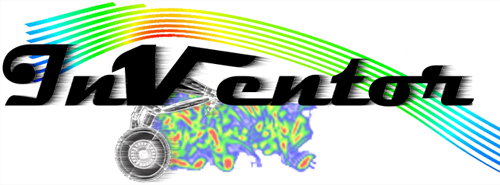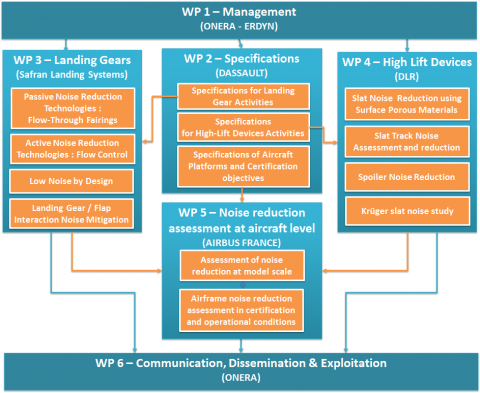Workprogram at a glance
INVENTOR will implement a clear methodology, taking advantage of the unrivalled expertise and complementarity of teams involved in the consortium, through a very cost-effective realisation of experimental tests and the application of up-to-date numerical methods. Basically, as presented hereafter on the workflow, through its various work packages, the project will:
provide detailed specifications of the configurations to be studied, for the baseline LGs and HLDs but also for the fully-installed versions of these components on generic aircraft configurations (WP2),
numerically and experimentally explore new low-noise designs, on the one hand, and promising NRTs on the other hand, both for LGs (in WP3) and for HLDs (in WP4), using realistic configuration with partial installation effects, balancing gains in terms of noise reduction with aerodynamic considerations,
assess the overall gains of the selected best HLDs and LGs designs and NRTs, through small scale tests on representative aircraft models and extrapolate the results at full scale both for certification purpose and in operational condition (WP5),
bridge the outcomes of the project with the European Research Roadmap on Aviation Noise in the framework of the H2020 Open Data policy (WP6), and implement tailored actions to fully exploit and disseminate the results.
Workprogram
| WP | Title | Leader | Duration | |
| WP1 | Management | ONERA, ERDYN | M1-M48 | Learn more |
| WP2 | Specifications | Dassault Aviation | M1-M32 | Learn more |
| WP3 | Landing Gear Noise Reduction | Safran Landing Systems | M1-M34 | Learn more |
| WP4 | High Lift Devices Noise Reduction | DLR | M2-M34 | Learn more |
| WP5 | Noise Reduction Assesment at Aircraft Level | Airbus | M25-M45 | Learn more |
| WP6 | Communication, Dissemination and Exploitation | ONERA | M1-M48 | Learn more |
Rationale of the work program
- Two main end-users
- Short Medium Range aircraft
- Business Jet aircraft
- Various airframe components architecture/installation
- Landing gear architecture : straight arm / trailing arm
- Landing gear installation (doors, bay)
- Slat/flap architecture and kinematics
- Various Interests on noise reduction technologies
- Add-on NRTs (passive/active) for LG : flow-through fairings, flow control
- Design-to-noise approach for LG, spoiler, slat tracks
- Low noise slat with surface porous materials
- Consequences on component / aircraft platforms choice
- Two different landing gear architectures
- Two complementary generic aircraft models
WP1 - Management
Objectives
- to ensure efficient coordination of the consortium throughout the project
- to enable fluid communication among participants and with EC
- to monitor the progress of the tasks and deliverables of WP
- to foresee any risks of delay and set up mitigation plans and corrective actions
- to implement a quality management
WP2 - Specifications
Missions and objectives
- To describe in details activities for :
- Landing gears noise reduction at component level, including full scale (link to WP3)
- High lift devices noise reduction at component level (link to WP4)
- Aircraft noise reduction with all installation effects (link to WP5)
- at WT model scale
- at full scale in certification and operational conditions
To be specified
- Noise metrics and noise reduction objectives at component level (LG and HLD)
- Materials (add-on) and low-noise designs to be tested as NRTs
- Windtunnel tests to characterize
- acoustic materials, e.g. databases to be provided for the calibration of CFD models
- NRTs and low noise designs
- at component level (HLD and LG, including full-scale MLG in S2A)
- at airframe level: small-scale generic aircraft models, for the selection of best NRTs and the assessment of CFD Results
- Direct numerical approach (CFD/LBM) to acoustically design LG (Design-To-Noise approach)
WP3 - Landing Gear Noise Reduction
Missions and objectives
- To select and assess the most promising landing gear noise reduction solutions
- Passive / active add-on technologies
- Low noise design via intensive CFD/CAA
- To develop, and implement in CFD/CAA solvers, numerical models for the simulation of noise reduction technologies and validate them with dedicated experiments
- To improve our capacity to apply up-to-date numerical simulations methods to optimize low noise landing gears with realistic installation and interactions effects
Noise reduction technologies to be studied in INVENTOR ⇒ Learn more
- Passive add-on NRTs : flow-through fairings
- Active add-on NRTs : local flow control
- Design-to-noise approach : low noise landing gear design via CFD/CAA
- Investigation of optimized low-noise boggie/leg incidence
- Landing gear / flap noise interaction mitigation
WP4 - High Lift Devices Noise Reduction
Missions and objectives
- To assess and select the most promising high lift devices noise reduction solutions
- Passive / active add-on technologies
- Low noise design via CFD/CAA
- To develop, and implement in CFD/CAA solvers, numerical models for the simulation of noise reduction technologies and validate them with dedicated experiments
- To improve our capacity to apply up-to-date numerical simulations methods to design slat cove liners and low noise slat tracks with realistic installation and interactions effects
Noise reduction technologies to be studied in INVENTOR ⇒ Learn more
- Low noise slat based on surface porous materials
- Low noise slat functional devices (slat tracks, anti-icing tubes and slat actuators)
- Spoiler noise investigation
- Krüger slat noise investigation
WP5 - Noise Reduction Assesment at Aircraft Level
Missions and objectives
- In wind-tunnel scale/conditions :
- To assess the most promising noise reduction technologies and innovative low noise designs with realistic installation effect, at component and aircraft level
- To validate our capability to predict the efficiency of these noise reduction approaches
- At full scale
- To derive/extrapolate the efficiency of these noise reduction approaches at aircraft level in approach certification and operational conditions, for two mid-term generic aircraft platforms :
- Short Medium Range Transport aircraft
- Business Jet aircraft
- To evaluate and rank the potential of noise reduction solutions for future aircraft
- To derive/extrapolate the efficiency of these noise reduction approaches at aircraft level in approach certification and operational conditions, for two mid-term generic aircraft platforms :
Approach
- Select the best NRT approaches from WP3 and WP4
- Implement them on two aircraft half-models :
- Short Medium Range Transport aircraft generic model
- Business Jet aircraft generic model
- Test them at small scale in DNW/NWB
- Assess the global noise reduction at model scale
- Extrapolate results at full scale on virtual aircraft platforms
WP6 - Communication, Dissemination and Exploitation
Missions and objectives
- to communicate, disseminate and exploit the project results
- to transpose scientific findings into a format comprehensible for non-scientific community
- to ensure the management of the data collected within WP
- to ensure an efficient IP management
- to contribute to maximizing the impact of the project results after the end of the project

